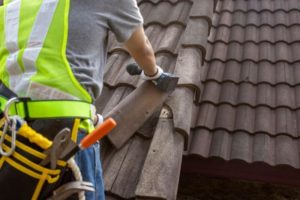When was the last time you checked your roof? Many homeowners in Gaithersburg, MD, overlook their roof’s condition until major problems arise, which can lead to costly repairs. Knowing how often you should replace your roof is crucial for maintaining a safe and comfortable home.
In this guide, we’ll explore the typical lifespan of roofs, the signs it’s time for a Gaithersburg roof replacement, and the factors that should influence your decision.
How Often Should You Replace Your Roof
The answer to how often you should replace your roof depends on several factors, including your roof material and how well it’s been maintained. Here’s an overview of typical roof lifespans:
- Asphalt Shingles: 20-30 years
- Metal Roofs: 40-70 years
- Wood Shingles: 30-40 years
- Clay/Concrete Tiles: 50+ years
The climate in Gaithersburg, with its extreme temperatures, snow, and rainfall, also affects the lifespan of your roof. Regular inspections can help you identify issues before they become major problems.
Factors That Affect Roof Lifespan
Several factors influence how often you should replace your roof, especially in Gaithersburg’s specific climate. Here are the key elements to consider:
- Climate and Weather Conditions: Gaithersburg experiences a variety of weather, including heavy rainfall, snow, and temperature extremes. These conditions can wear down roofing materials faster than in milder climates, shortening their lifespan.
- Roof Material: The type of roof you have plays a significant role in its longevity. Asphalt shingles generally last 20-30 years, while metal roofs can endure 40-70 years. Other materials, like clay tiles or wood shakes, may have a longer lifespan but can still be impacted by the region’s weather conditions.
- Roof Maintenance: Regular maintenance, including annual inspections and timely repairs, can help extend the life of your roof. Well-maintained roofs are more likely to last longer and reduce the need for early replacements.
- Age of the Roof: If your roof is approaching the end of its expected lifespan, it may be time to start planning for a replacement. Roofs lose their protective capabilities as they age, and replacing them before they fail entirely can save you from costly water damage repairs.
Signs That It’s Time to Replace Your Roof

You should consider replacing your roof if you notice any of the following signs:
Missing or Damaged Shingles
If you see cracked, curling, or missing shingles, it’s an indication that your roof is deteriorating.
Leaks and Water Damage
Water stains or leaks in your attic are a strong sign that your roof is no longer protecting your home from water intrusion.
Sagging Roof Deck
A sagging roof deck could be a sign of serious structural issues and requires immediate professional attention.
Granules in Gutters
If you notice granules from asphalt shingles in your gutters, it means your shingles are wearing out and losing their protective coating.
Roof Material and How Long It Lasts
The type of roofing material you choose directly affects how long your roof will last. Here’s a breakdown of the most common roofing materials and their typical lifespans:
- Asphalt Shingles: These are the most common and affordable roofing material, typically lasting 20-30 years. However, they are more susceptible to damage from extreme weather conditions, such as high winds and hail.
- Metal Roofs: Known for their durability, metal roofs last 40-70 years, withstanding severe weather conditions like heavy snow, rain, and intense heat.
- Wood Shingles: Wood roofing can last 30-40 years, but it may be more prone to rot or mold, especially in humid climates like Gaithersburg’s.
- Clay or Concrete Tiles: These materials are incredibly durable, with lifespans that often exceed 50 years. They can withstand intense weather but may crack under heavy impact.
Roof Repair vs. Roof Replacement
In some cases, roof repair in Gaithersburg can help extend the life of your roof, but when extensive damage occurs, a replacement is the best option. Here’s when roof replacement is typically needed:
- Roof nearing the end of its lifespan: If your roof is over 20 years old and showing signs of wear, it might be time to replace it.
- Multiple areas of damage: If your roof has several leaks or damaged sections, repairing individual parts may not solve the problem in the long run.
- Multiple layers of shingles: If you have more than two layers of shingles, a full replacement is often required to maintain the structural integrity of your roof.
Cost of Roof Replacement in Gaithersburg, MD
The cost of replacing your roof in Gaithersburg varies depending on several factors, including the size of your roof, the material used, and the contractor you hire. On average, homeowners can expect to pay anywhere from $5,000 to $10,000 for a full roof replacement. However, the final cost could be higher or lower depending on your unique circumstances.
Factors that influence cost include:
- Roof Size: Larger roofs will naturally cost more to replace.
- Roof Material: High-end materials like metal or tile will increase the overall cost.
- Labor Costs: The complexity of your roof design and labor rates in your area will also impact the price.
How to Extend the Lifespan of Your Roof
Regular roof maintenance can delay the need for a roof replacement. Here are some tips to help extend the life of your roof:
Clean your gutters regularly
Clogged gutters can cause water damage, leading to early roof deterioration.
Trim overhanging branches
Limbs that scrape against the roof can cause damage over time, so keep trees trimmed back.
Inspect your roof annually
Even if there are no obvious signs of damage, regular inspections can catch small issues before they become costly repairs.
Remove moss or algae
If moss or algae is growing on your roof, it can cause shingles to deteriorate. Clean them off carefully to prevent damage.
Choosing a Roofing Contractor in Gaithersburg, MD
When it’s time to replace your roof, it’s crucial to choose local roofing contractors who understand Gaithersburg’s weather and building codes. Here are some tips to help you find the right professional:
Licensed and insured
Make sure the contractor is licensed and insured to protect yourself in case of any accidents or issues during the job.
Get multiple quotes
Don’t settle for the first estimate. Getting multiple quotes will help you compare prices and services.
Check references and reviews
Look at online reviews and ask the contractor for references to ensure you’re hiring someone trustworthy.
Local expertise
Choose a contractor familiar with Gaithersburg’s weather conditions and local building codes.
Conclusion
Knowing how often you should replace your roof is essential for maintaining a safe and comfortable home. Regular inspections, timely repairs, and proper maintenance can help extend the lifespan of your roof and prevent costly replacements. If you notice any signs of damage or if your roof is nearing the end of its expected lifespan, it’s important to consult a professional to evaluate the condition of your roof.
Taking proactive steps now can save you from more expensive repairs down the line. A well-maintained roof not only protects your home but also adds value and peace of mind for years to come.


